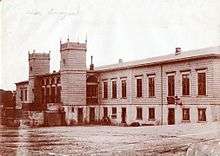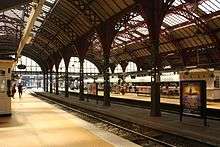Copenhagen Central Station
| S-train and DSB station | |
 Front facade seen from Vesterbrogade | |
| Location |
Bernstorffsgade 16–22 DK-1557 Copenhagen V |
| Coordinates | 55°40′22″N 12°33′52″E / 55.67278°N 12.56444°ECoordinates: 55°40′22″N 12°33′52″E / 55.67278°N 12.56444°E |
| Owned by | DSB |
| Operated by | DSB |
| Platforms | 7 |
| Tracks | 13 |
| Construction | |
| Architect | Heinrich Wenck |
| History | |
| Opened | 1 December 1911 |
| Rebuilt | 15 May 1934 (S-train) |
| Electrified | 1934 (S-train), 1986 (Mainline) |
| Location | |
 Copenhagen Central Station Location within Denmark | |
Copenhagen Central Station (Danish: Københavns Hovedbanegård, abbreviated København H) is the main railway station in Copenhagen, Denmark and the largest railway station in Denmark, although Nørreport Station has a larger passenger throughput if urban S-train and Metro services are included. It is situated between the districts of Indre By and Vesterbro with entrances from Bernstorffsgade (at Tivoli Gardens), Banegårdspladsen, Reventlowsgade and access to platforms from Tietgensgade.
Copenhagen Central Station is the hub of the DSB railway network serving Denmark and international destinations.[1] It offers InterCity and Express trains services across Denmark, as well as services to several international destinations, regular and frequent regional train services to and from Zealand and southern Sweden (also referred to as Øresund trains). The station also services the Copenhagen S-train network, but the S-train system in Copenhagen doesn't use any kind of hub at all. It is an urban transit which differs from most Metro system mainly by being a type of railway. At the station are two platforms with four tracks used by the S-trains only. All other trains usually use some of the other four platforms and eight tracks.
To the original 12 platform [2] tracks far later a single spare track has been built, now called track 26. It has occasionally been used for trains to or from Sweden. After the introduction of border controls and mandatory identity checks for travel to Sweden this track was fenced and used for X2000 and intercity trains to Sweden. The extra track 26 is located 200 metres (660 ft) south of the main building and is reachable only by walking along the platform for track 4 and 5 or from a staircase from the Tietgensgade street.
The platforms begin under the main passenger hall (and at least the S-train section of the station can be said to begin as an underground station). A hotel (Astoria) is built above the S-train tracks in the Northern end, but the remaining tracks drives uncovered below street level. (Open areas between tunnel sections were necessary to have during the era of steam trains, while the S-trains always have been electrical) In the opposite (platform) end are all platforms covered with the typical railway arched roof. This roof is though shorter than the platforms, but all tracks remain below street level and can also be accessed from the street Tietgensgade.
The main hall isn't just a waiting hall, but also a market place where most things can be bought. From fresh fruit sellers to super market, postal office, banks, currency exchanges, hamburgers, coffee shops, restaurants and pubs etc. There are also travel center for information an manual sale of tickets and two large toilet sections which are under manual supervision and clean. Also shower rooms are available for a smaller fee.
The current station building opened in 1911 and is the work of architect Heinrich Wenck. The station has 7 platforms and 13 tracks. On the station concourse there are many small shops, cafeterias, and fast food outlets. All public transport within Greater Copenhagen are divided into close to 100 ticket fare zones. The Central station is located in fare zone 1, which together with zones 2 and 3 constitute Copenhagen municipality and the "exclave" of Frederiksberg municipality. And as the cheapest single ticket always is valid in two zones, is a single ticket bought at the station valid whithin the entire city centre and its inner boroughs. Though - a ticket to Copenhagen Airport Kastrup demands the payment for three zones, as it's located in zone 4.
From December 2018 will the Central station also be served by the new Copenhagen Metro line M3, which will be a circular line with 17 stations.[3][4] Further, less than a year later will the metro service also include line M4.[5] However is both projects currently several months delayed, and the opening of line M3 may be postponed up to six months.[6]
History

The first railway station in Copenhagen was built in 1847, approximately at the present station location. It served Roskildebanen, and it was made of wood because it was built outside the fortifications where buildings with foundations were not allowed. This was soon necessary due to plans to extend the railway network in Denmark. A new larger station, designed by H. J. Herholdt, opened in 1864.
The second station also proved too small, especially because there was only one track leading out of the city. It was decided to build a new station, including a tunnel to Østerport station, and with tracks out of the city to the south. Designed by Heinrich Wenck, the present station was finished on 1 December 1911. The tunnel (the Boulevard Line) was opened in 1917.
The station was overhauled in 1980. Escalators and lifts were established to the platforms, and the station concourse, which was originally split into arrival, departure, and freight sections, was redone completely. The station was overhauled again from 2004 to 2008. This overhaul replaced the roof, lowered platforms 3 to 6 to international standards and lengthened them. The towers and the bridge over the platforms, upon which the main station building is placed, were reconditioned.
Services

Copenhagen Central Station provides Copenhagen with Intercity and Express trains across Denmark, as well as services to several international destinations. Direct international trains connect to Stockholm, Hamburg and Berlin several times a day. Intercity trains run half-hourly from Copenhagen during daytime and serve as a link between the major cities and towns in Denmark, including Odense, Aarhus, Aalborg, Esbjerg, Frederikshavn, Thisted and Sønderborg. Regional trains (stops at major stations within the Greater Copenhagen area) connect the main parts of Zealand to the capital. Veolia Transport trains on the Oresundtrain regional rail network depart to southern and western Sweden every 20 minutes. A special ticket fare system exists between the Copenhagen local traffic area and the most southern part of Sweden, Skåne county.
All S-train services except the F-line stop at the station.
Copenhagen Central Station
| Preceding station | S-train | Following station | ||
|---|---|---|---|---|
toward Frederikssund | H | toward Farum |
||
| C | toward Klampenborg |
|||
toward Høje Taastrup | Bx | toward Østerport |
||
| B | toward Holte |
|||
toward Køge | E | toward Hillerød |
||
toward Solrød Strand | A | toward Farum |
||
| Preceding station | Danske Statsbaner | Following station | ||
toward Copenhagen Airport | Copenhagen - Frederikshavn InterCity | toward Frederikshavn |
||
| Copenhagen-Aarhus-Struer InterCity | toward Struer |
|||
| Copenhagen-Herning-Struer-Thisted InterCity | toward Thisted |
|||
| Copenhagen-Esbjerg InterCity | toward Esbjerg |
|||
| Copenhagen-Sønderborg/Padborg InterCity | toward Sønderborg or Padborg |
|||
| Terminus | Copenhagen-Ystad/Bornholm InterCity | toward Rønne |
||
toward Helsingør | Coast Line Øresundståg | toward Malmö C |
||
| Elsinore-Roskilde | toward Roskilde |
|||
| Copenhagen-Roskilde | ||||
| Copenhagen-Odense | toward Odense |
|||
toward Østerport | Copenhagen-Nykøbing F/Rødby/Gedser | toward Rødby Færge or Gedser |
||
| Copenhagen-Kalundborg | toward Kalundborg |
|||
| Preceding station | Deutsche Bahn | Following station | ||
| Terminus | ICE 75 | towards Berlin Ostbahnhof |
The future
København H is not connected to the Copenhagen Metro network, but will become so following the completion of the Metro's future City Circle Line, expected by 2018.
Because of a new railway between Copenhagen and Ringsted (planned for construction start 2013), the station needs more capacity. There is already congestion on the tracks. The Danish Ministry of Transport has started planning of an extension: proposals include a four-track terminal station on a bridge over the present tracks, or in a tunnel under them.
See also
External links
![]() Media related to Københavns Hovedbanegård at Wikimedia Commons
Media related to Københavns Hovedbanegård at Wikimedia Commons
- - Copenhagen-Portal - Central Station of Copenhagen
- Danish State Railways
- S-train
- Danish Rail Transport Agency
- Danish Ministry of Transport
- Copenhagen Traffic Information
References
- ↑ "Travelling in Denmark". DSB. Retrieved 25 November 2013.
- ↑ http://denstoredanske.dk/Bil,_b%C3%A5d,_fly_m.m./Jernbane/Jernbaneanl%C3%A6g/K%C3%B8benhavns_Hovedbaneg%C3%A5rd
- ↑ http://www.m.dk/#!/om+metroen/metrobyggeriet/om+cityringen
- ↑ All stations were built firs this site shows how far the drilling of the tunnels have come
- ↑ All the first four lines are shown here, a bit down
- ↑ http://www.m.dk/#!/om+metroen/metrobyggeriet/om+cityringen/tidslinje